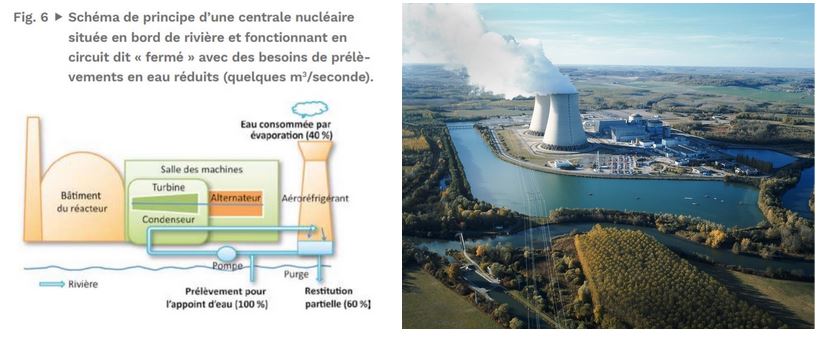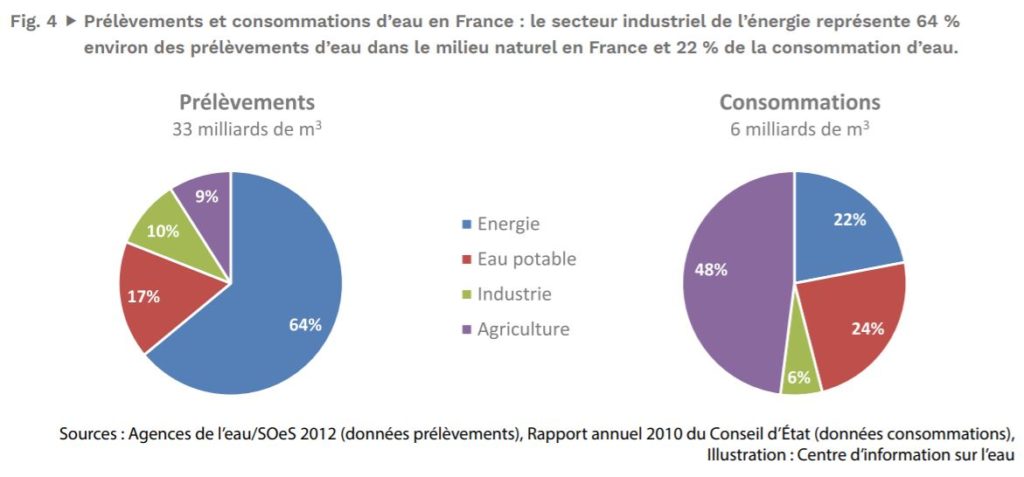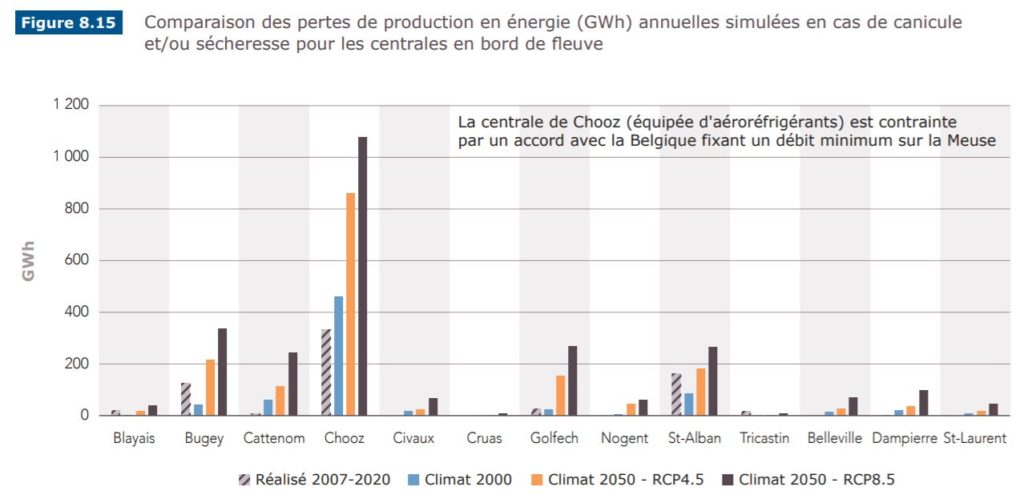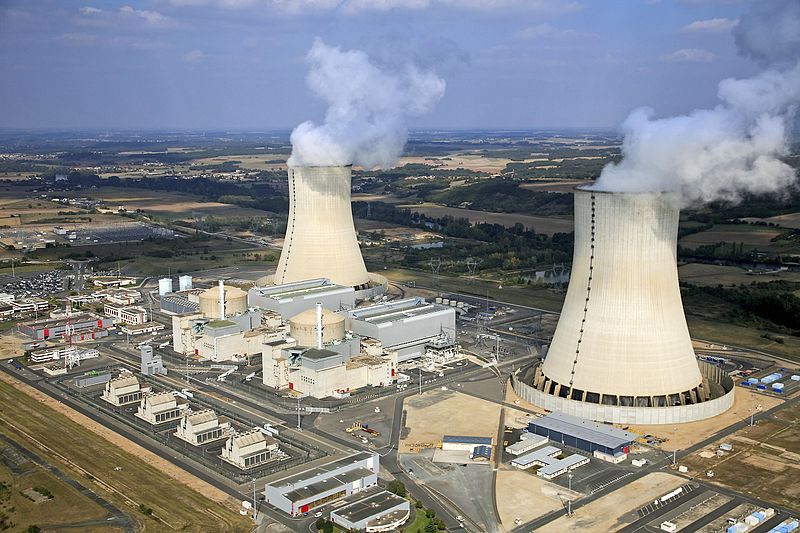Nuclear power plants, which produce low-carbon electricity in the same way as renewable energies, are a way of tackling climate change.
However, as the issue of the electricity mix becomes more prominent in the public debate, the legitimate question of whether nuclear power plants are compatible with our future climate is regularly raised. Indeed, like any other infrastructure project, it must be compatible with the climatic conditions it may encounter during its lifetime.
We propose to examine this issue through two themes:
- The first is the ability to produce electricity, i.e. the availability of plants when they are needed.
- The second is safety, i.e. the ability of a plant to maintain its integrity in the face of various events, including extreme ones (an exceptional flood, for example), and thus avoid the occurrence of nuclear incidents or accidents.
Article by Kévin Arnoux
Climate change impacts on electricity production by nuclear power plants in France
How does climate change affect power plants?
What are the scientific studies on climate change saying? Depending on the emission scenarios, studies compiled by the IPCC model that by the end of the century:
- average temperatures will rise between +1.5°C and +5°C.
- average sea level will rise between +0.5m and +1m.
- and from 2050, average temperature of rivers in France will rise by +2°C.


Meanwhile, the Explore 2070 project, supported by the Office Français de la Biodiversité (French Office for Biodiversity), anticipates a drop in the average annual flow of rivers in France of between 10% and 50%.
Limits on thermal discharges from a nuclear power plant
For nuclear reactors, two cooling requirements can be distinguished:
- The cooling of the steam condenser of the turbine-generator unit related to the production of electricity, hence only valid for a running reactor. This is the requirement that generates the greatest need for water. It is found for most thermal power plants (coal, gas, geothermal, solar thermodynamic, etc.).
- The cooling of the nuclear auxiliaries that ensure safety functions. This requirement is specific to nuclear reactors and is considerably smaller in volume than that of the turbine. For example, if a reactor is shut down, residual heat released by the core is considerably less; water withdrawals, necessary only for the nuclear auxiliaries, would be up to 100x lower than for a operational reactor.
Thus, reactor shutdowns reported in the press in summer/autumn are performed:
- Either independently of the climate, for regular maintenance. Summer being a favourable time because electricity consumption is lower than the rest of the year.
- Or to comply with the regulatory limits set for each power plant on its thermal discharges (mainly due to cooling needs of the turbine).
Regulatory limits
Why are there limits on thermal discharges? According to the Autorité de Sûreté Nucléaire (ASN, Nuclear Safety Authority) :”The limits imposed on heat[thermiques] discharges from power plants[centrales] are intended to prevent a change in the immediate environment, particularly for fish, and to ensure acceptable sanitary conditions if water intakes for human consumption exist downstream. In addition to these limits on thermal discharges, power plants must control radioactive and chemical discharges into rivers in accordance with regulatory obligations related to flow rate.
Three types of regulatory limits exist:
- A maximum temperature that the river must not exceed downstream of the power plant or at the discharge location for seaside power plants. For instance, this limit is set to 28°C for the Golfech power plant that discharges into the Garonne river.
- A maximum warming threshold for the river between upstream and downstream of the power station. For example, +3°C in summer for the Rhône at the Saint-Alban power station.
- A regulatory threshold for maximum water withdrawal, possibly supplemented by minimum discharge flow thresholds. For example, water consumption/evaporation is prohibited for the Chooz power plant if the flow of the Meuse is less than 20m3/s on average over a 12-day period.
The first limit is likely to occur mainly during periods of heatwave, while the other two are more likely to occur during periods of drought, when the river is at its weakest flow.
Different types of cooling in a power plant
Before going into the details of production losses due to the current and future climate, it is important to make a short passage through the technology by understanding how a nuclear power plant is cooled. Two main types of design exist for cooling.
The first option, the so-called “open circuit”, the volume of water withdrawn is significant (of the order of 50m3/s per reactor) but is almost entirely returned to the source. In this case, the well-known cooling towers are not present. This is the case for seaside plants, such as Paluel.

Second option, a so-called “closed circuit”, the volume of water taken is small (2-4m3/s per reactor) but, instead of being discharged at the source, this water is cooled by evaporating in part ( the same as transpiration!) and then returned to the plant. Overall, 40% of the water withdrawn will evaporate. This type of design is found in some (but not all) riverside power plants, for example Golfech.

Credits: EDF Centrale de Golfech: Jack Ma
In France, 14 reactors are currently in open circuit by the sea, 10 are in open circuit by the river and 32 are in closed circuit (with cooling towers) by the river.

This notion of water withdrawal vs. water consumption (what does not return to the source) is very important. On average, 98% of the water withdrawn by French nuclear power plants is returned to the source (i.e. only 2% of the water withdrawn is “consumed” by evaporation).

Then, it is obvious that power plants that are likely to have excessive thermal discharges into waterways are those with an open circuit. Indeed, with the presence of an air cooler, the thermal discharges are mainly…in the air!
Production losses due to climate change: current status
Before looking at the impacts of the future climate, let’s look at the production losses that are already linked to stoppages due to heat waves or drought.
According to RTE, the electricity transmission system operator, they are on average 1.4 TWh/year, i.e. less than 0.4% of annual nuclear production. In terms of capacity, these shutdowns can be substantial at a given time, with a peak of 6GW (10% of installed capacity) reached during the heat wave of July 2019.

Which nuclear power plants are affected?
The vast majority of the losses come from three power plants: Bugey, Saint-Alban and Chooz. What is the reason for this?
The first two are on the banks of a river and without cooling towers (this concerns two of the four Bugey reactors) and are therefore more sensitive to drought and heat waves. It should be noted that this combination of “riverside without cooling towers” is not sufficient to say that a plant is sensitive to drought/canicule. Thus, Tricastin, which has the same configuration but is located further downstream from the Rhône, is only slightly affected.
Chooz is a specific case because the plant is subject to a particular agreement between France and Belgium (which is downstream) on water sharing, which limits its withdrawal capacities.

It should be noted that none of the seaside power stations, which do not have cooling towers, are affected. Indeed, the sea, due to its size, has a considerable thermal dissipation power, which makes this type of power plant almost immune to heat wave/drought problems on this aspect.
Production losses due to climate change: what about the future?
Now that we have seen the current situation, let’s look at what might happen in the future in France with a modified climate.
For this, we will rely on the very comprehensive report by RTE Futurs énergétiques 2050 (released in October 2021) which explores different scenarios for the electricity mix in France in 2050 (for more information on this report, see the very good video by Le Réveilleur). In this report, an entire chapter is dedicated to the link between climate and the electricity system (which also includes consumption, wind, solar, dams, networks, etc.).
To study this problem, RTE uses Météo France simulations, which provides 200 possible versions of the meteorological year 2050. There are three different climates:
- A baseline climate that matches conditions in the 2000s
- A 2050 climate of the IPCC RCP4.5 scenario, i.e. an intermediate emissions trajectory that does not allow carbon neutrality to be achieved in 2050 and which therefore reflects a warming at the end of the century of between +2°C and +3.5°C
- A climate of the year 2050 in the IPCC RCP8.5 scenario, a very high emissions trajectory (fortunately considered unlikely today), which would lead to an average temperature rise at the end of the century between +3.5°C and +6°C

What variables are considered?
These simulations contain the most important data for the power system: temperature, wind, sunlight, precipitation and river flows.
According to RTE, for seaside power plants, global warming is not expected to cause environmental thresholds to be exceeded, which could lead to shutdowns, either for the RCP4.5 or the RCP8.5 scenario.
On the other hand, at unchanged regulations and technology, the production losses for riverside reactors are expected to be two to three times higher. It can be noticed that the vast majority of losses are located in the same power plants as today, namely Chooz (France-Belgium agreement), Bugey and Saint-Alban (no cooling towers). Next come Cattenom and Golfech, which do have cooling towers but which have the disadvantage of being located on smaller rivers, leading to problems of flow (the Moselle for Cattenom) or temperature (the Garonne for Golfech).
Thus, a power plant such as Cruas, located on the banks of a river with a fairly large flow rate and having cooling towers, will suffer almost no losses from heat waves and droughts, even in the most unfavourable IPCC scenario.

Overall, the average loss of production, taking into account the closure of some reactors and the opening of new ones, will be low at around 1-2 TWh/year with a maximum of 10 TWh in a very unfavourable year (around 3% of annual production).


A small but significant risk
The maximum simultaneous downtime risk with a one in ten probability of occurence in a given year is 6 GW (12% of installed capacity) for the RCP 4.5 trajectory and 8.5 GW (16% of installed capacity) for the RCP 8.5 trajectory.
RTE concludes: “In a context marked by an increase in peak consumption linked to air conditioning and increased risks of droughts at the end of the summer, these losses of available capability are not negligible. This shows the interest in finding ways to limit nuclear reactor fleet sensitivity to climate change.“And what are these ways? This will be discussed in the next section.
It should be noted that the RTE report only concerns France. Globally, a recent study published in Nature Energy forecasts climate change-related losses for all nuclear power plants to be between 1.4% and 2.4% per year by the end of the century (compared to 0.2% per year in the 1990s).
Chaque semaine, nous filtrons le superflu pour vous offrir l’essentiel, fiable et sourcé
Not the main source of trouble for the power grid
An important point in this report is that, although nuclear unavailability in the summer is an issue, it is not this type of weather event that is going to cause the greatest trouble on the electricity system. Indeed, RTE specifies: “In 2050, the most risky configurations correspond to situations of lack of wind combined with cold temperatures, in particular across Europe“.
This type of configuration involves a combination of high electricity consumption (in cold periods) and a high level of wind power development, which is essential for achieving France’s and Europe’s carbon neutrality objectives.

The key word: adaptation
According to the IPCC, there are two main drivers for tackling climate change:
- Mitigation, which refers to human interventions to reduce the sources or enhance the sinks of greenhouse gases. For example: replacing a coal power plant with a nuclear power plant or RE.
- Adaptation, which consists of implementing means to mitigate the negative effects of the current or future climate.
Considerably less discussed, adaptation is a key issue in climate policy, particularly in relation to energy. This raises the question of how to make nuclear power plants even more resilient to climate change.
First of all, possible future climates must be known, with simulations of air and water temperatures, etc. To do this, EDF has set up a climate monitoring process based on the IPCC scenarios.
1/ For existing nuclear power plants
Although this aspect will be described in more detail in the second part of this article dedicated to security, it is still important to mention the plan “Grand chaud” This includes expanding the capacity of cooling units, heat exchangers and checking the performance of equipment at higher temperatures than specified in the original design, as well as rules of conduct to prevent, detect and control the consequences of high temperatures on reactor operation.
From a theoretical point of view, one solution that might come to mind would be to do some work to change from an open circuit (without a cooling tower) to a closed circuit (with a cooling tower). This particularly complex and costly project would potentially not be profitable in view of the gains expected over the rest of the plants’ lifespan. For example, one study estimated that retrofitting the 63 plants concerned in the USA (60GW) would cost $32 billion (work and non-production during this work).
2/ For future power plants
The first step would be to find a suitable location. Indeed, as we have seen, choosing a seaside site is an excellent protection against heat waves and droughts. For a riverside site, a river with a sufficiently large flow should be preferred. It is thus considerably easier to understand EDF’s proposals for the potential future nuclear power plant programme (known as EPR2) in France, with two sites on the coast (Gravelines in the North and Penly in the Seine-Maritime) and one on the Rhone (Bugey in the Ain or Tricastin in the Drôme).
For these future reactors, having cooling towers from the outset seems to be the best idea, as recommended in the article 4.1.7. of the INB (Nuclear Facility) decree : “Open-circuit cooling with fresh water from the environment is prohibited, unless explicitly stated in the authorisation decree. In order to benefit from this derogation, the operator must justify the acceptability of this practice, in particular with regard to the thermal impact of the discharges into the environment.”
As an example of what can be done on the design side, the Civaux nuclear power plant, the last nuclear power plant to be commissioned in France, is a model in this field. It has two large “classic” cooling towers, but also additional small cooling towers (called “purge towers”) to cool the water a second time before it is returned to the river, which allows the heating to be suppressed as soon as the Vienne temperature reaches 25°C in summer.
Finally, the cooling of the nuclear auxiliaries is also done with cooling towers and its water management is optimised with a water reservoir upstream which provides assistance for low water levels. It is therefore currently unaffected by heat wave/drought shutdowns even though it is located on one of the smallest rivers in France with a nuclear power plant.

A look at the world
To broaden the horizon, it may be interesting to study what is being done in other countries around the world.
The Palo Verde plant is often mentioned in discussions on the subject. In the middle of the Arizona desert, it is not connected to the sea or to any watercourse, but uses the wastewater from the city of Phoenix, 70 km away, to cool itself (with cooling towers).
To be able to operate with this water source, the power plant reprocessed it a second time and built 52 hectares of storage reservoirs. To optimise its water use and costs, the plant is currently looking for alternative sources of water of lower quality.

An example of a power plant that operates in a very hot climate (water temperature up to 35°C and air temperature up to 50°C) is the Barakah power plant in the United Arab Emirates, which started up in 2021 and is cooled by the sea. Compared to its model in Shin-Kori, South Korea, the seawater temperature here is higher and the water heating limit set by the authorities is more restricted (only 5°C).
These constraints were taken into account through design modifications on Barakah by increasing, among other things, the capacities of the condenser, the pumps and by introducing a thermal dissipation system for the heated water before discharge into the sea. It should be noted that in extreme cases such as this, there is a slight loss of theoretical efficiency (-6%, i.e. -90MWe) compared to the reference reactor due to the +15°C increase in the temperature of the water source.
One example of post-commissioning adaptation is the Asco nuclear power plant in Spain, which has the distinction of having built an air cooling tower 10 years after start-up to cool the water before discharging it into the river.
Additionaly, the “dry cooling” technology uses heat exchange between the outside air and water but without evaporation. This is particularly true of large coal-fired power stations in South Africa.

This relatively extreme technology, which is not currently used for nuclear power, is unlikely to become widespread for large plants. In contrast, this is the system that will be proposed for Nuscale’s first SMR (small nuclear reactor) in Idaho.
Rising sea levels
Adaptation issues also exist for all other climate events, such as rising sea levels. Having said that, this consideration of sea level variations is not new to the nuclear industry. For example, the Hinkley Point power station in England is subject to the second highest tidal range (difference between high and low tide) in the world: up to 15m variation in one day!
To protect against high tides, rising sea levels or flooding, the best solution is to build the power station high enough and to supplement this with a flood barrier. For example, the future Hinkley Point C EPR is 13.5m above mean sea level. This topic will be discussed in more detail in the second part of this article, devoted to safety!


Conclusion
Climate change is unfortunately a reality and its negative effects will only get worse in the coming years. Beyond implementing the means to limit it, it is crucial to ask the question of the vulnerability of each element of our system (economic, social, environmental) to this future climate. Nuclear power, like the entire energy sector, is no exception.
Losses of electricity generation due to climate change are currently low and are expected to remain limited over the course of the century, both in France and worldwide. In France, they mainly affect only a limited number of power plants, in particular those cooling via river water of modest size and/or without air coolers.
For potential future EPRs with a lifetime up to the end of the century, there are effective adaptation measures to limit the impact of climate stress, for example in the choice of location or in the design of its cooling system. Although the effect in terms of available capacity may be more significant than in terms of annual energy losses, the main stress situation for the balance of the French electricity system in the years to come will not be a heat wave/drought episode but rather a cold day without wind.
Finally, this problem, although real, is not inevitable and its impact remains limited. It does not therefore appear to discriminate in the choice of whether or not to use nuclear power.













